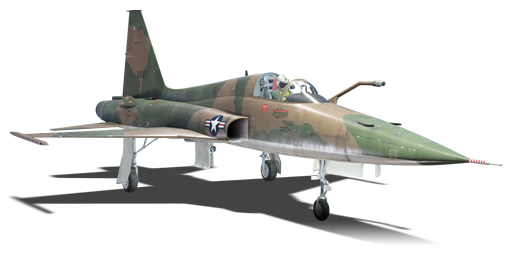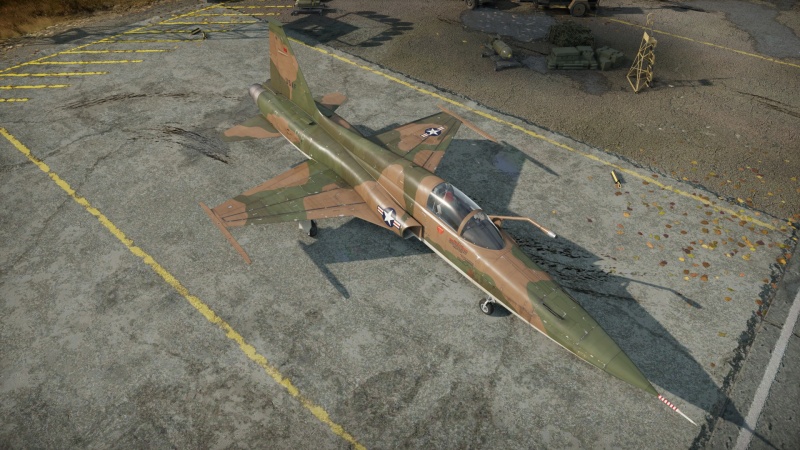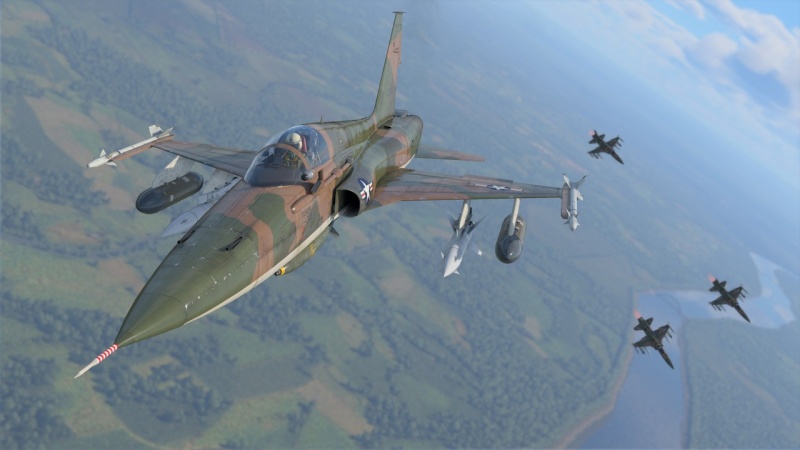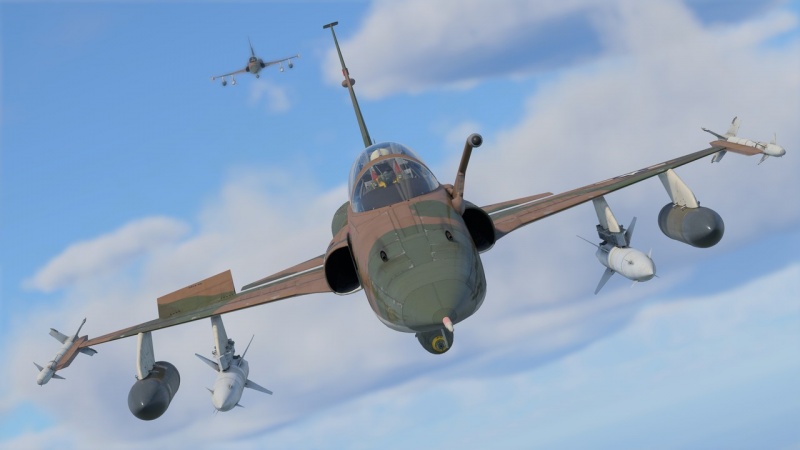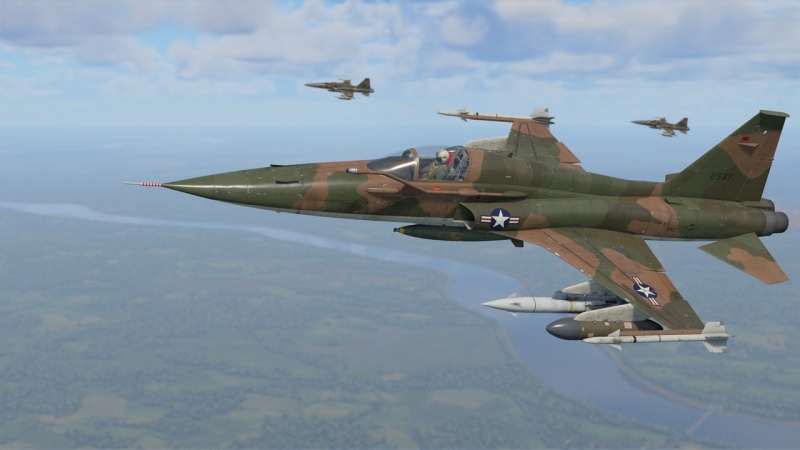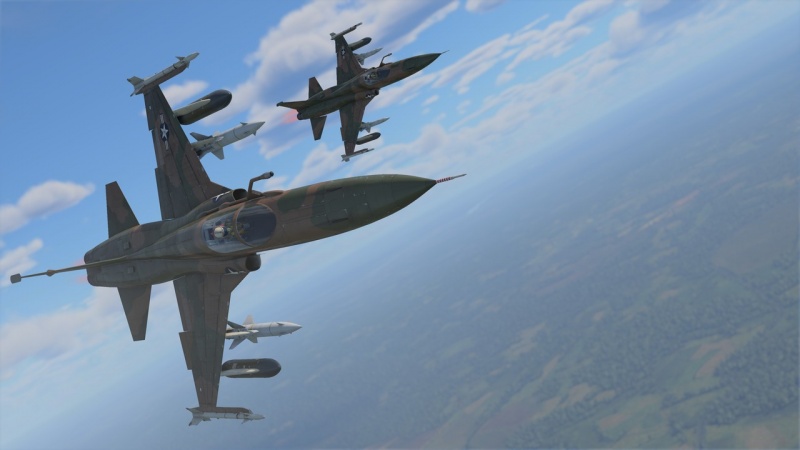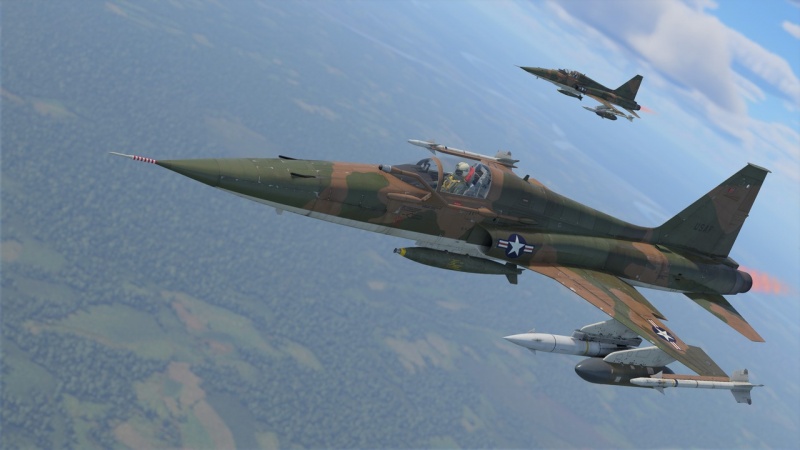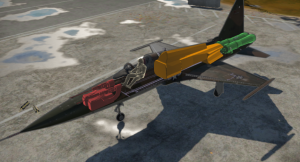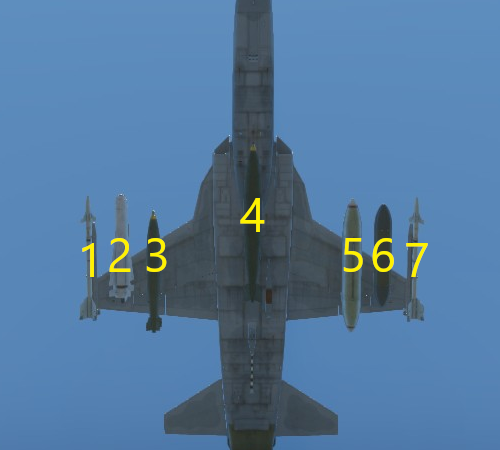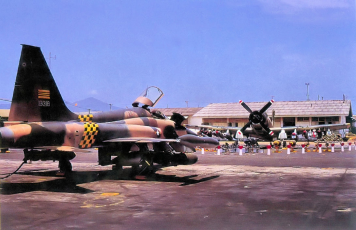Difference between revisions of "F-5C"
(→Suspended armament: Updated) |
(→Suspended armament: Updated) |
||
| (25 intermediate revisions by 12 users not shown) | |||
| Line 12: | Line 12: | ||
== Description == | == Description == | ||
<!-- ''In the description, the first part should be about the history of and the creation and combat usage of the aircraft, as well as its key features. In the second part, tell the reader about the aircraft in the game. Insert a screenshot of the vehicle, so that if the novice player does not remember the vehicle by name, he will immediately understand what kind of vehicle the article is talking about.'' --> | <!-- ''In the description, the first part should be about the history of and the creation and combat usage of the aircraft, as well as its key features. In the second part, tell the reader about the aircraft in the game. Insert a screenshot of the vehicle, so that if the novice player does not remember the vehicle by name, he will immediately understand what kind of vehicle the article is talking about.'' --> | ||
| − | The '''{{Specs|name}}''' is | + | During the Vietnam War, the USAF requested F-5 Freedom Fighters due to the high loss rates of other aircraft in use. The Defense Department originally rejected the proposal but later accepted it in 1965. Codenamed "Skoshi Tiger", the USAF would use 12 F-5A's from the Military Assistance Program (MAP) for performance evaluations. They would eventually receive inflight refueling probes, lead-computing gunsight, significant armour on the belly, and designated as the F-5C Skoshi Tiger. The Skoshi Tiger program would later end with the DoD rejecting a second proposal for more F-5's. |
| + | |||
| + | Introduced in [[Update "Red Skies"]] as a premium fighter, the '''{{Specs|name}}''' is an excellent fighter. Firstly, the F-5C has access to countermeasures which is incredibly important for its battle rating. Furthermore, the F-5C has a low heat signature which helps against evading IR missiles. The F-5C also can carry two AIM-9E Sidewinders which are decent but players should not rely on them to get kills. The two 20 mm cannons mounted in the nose will be the primary way of downing enemy aircraft along with its excellent performance. Although it can carry bombs, players should stick to using it as a fighter where it shines. | ||
== General info == | == General info == | ||
| Line 18: | Line 20: | ||
{{Specs-Avia-Flight}} | {{Specs-Avia-Flight}} | ||
<!-- ''Describe how the aircraft behaves in the air. Speed, manoeuvrability, acceleration and allowable loads - these are the most important characteristics of the vehicle.'' --> | <!-- ''Describe how the aircraft behaves in the air. Speed, manoeuvrability, acceleration and allowable loads - these are the most important characteristics of the vehicle.'' --> | ||
| − | The F-5C is generally an all-round good fighter. It's not the fastest plane and not the most manoeuvrable, but the combination of its decent speed, acceleration, and manoeuvrability make it a joy to fly and fight in. | + | The F-5C is generally an all-round good fighter. It's not the fastest plane and not the most manoeuvrable, but the combination of its decent speed, acceleration, and manoeuvrability make it a joy to fly and fight in. The F-5C has excellent turn rate and energy retention while maintaining a speed above Mach 0.85. |
{| class="wikitable" style="text-align:center" width="70%" | {| class="wikitable" style="text-align:center" width="70%" | ||
| Line 112: | Line 114: | ||
{{Specs-Avia-Armour}} | {{Specs-Avia-Armour}} | ||
<!-- ''Examine the survivability of the aircraft. Note how vulnerable the structure is and how secure the pilot is, whether the fuel tanks are armoured, etc. Describe the armour, if there is any, and also mention the vulnerability of other critical aircraft systems.'' --> | <!-- ''Examine the survivability of the aircraft. Note how vulnerable the structure is and how secure the pilot is, whether the fuel tanks are armoured, etc. Describe the armour, if there is any, and also mention the vulnerability of other critical aircraft systems.'' --> | ||
| + | [[File:F-5C layout.png|thumb|right|F-5C's layout of components]] | ||
| + | |||
| + | The F-5C is not protected by armour plates. This leaves the engine and other critical plates vulnerable to ground fire. However, the F-5C is a relatively small target to hit which mitigates the lack of armour. There are two fuel tanks mounted in the centre of the fuselage behind the pilot, both of which are self-sealing. The F-5C is surprisingly durable in-game and can take a few hits before being counted as destroyed. | ||
| − | + | The F-5C also has 60 countermeasures which in combination with the low heat signature, greatly helps with evading IR missiles. Even strong IR missiles like the [[AIM-9L]] can easily be flared off. Unfortunately, the countermeasure drops in pairs so one drop means the loss of two countermeasures. With a mixed loadout, players will only have 15 drops before running out. Due to the F-5C's battle rating, it's better to choose standard flares as players will receive 30 drops and radar missiles are not a major threat yet, unless meeting planes like the MiG-21 at high-altitudes. | |
| − | |||
| − | |||
=== Modifications and economy === | === Modifications and economy === | ||
| Line 129: | Line 132: | ||
The '''''{{PAGENAME}}''''' is armed with: | The '''''{{PAGENAME}}''''' is armed with: | ||
| − | + | * 2 x 20 mm M39A2 cannons, nose-mounted (280 rpg = 560 total) | |
| − | + | * 60 x countermeasures | |
| − | * | ||
=== Suspended armament === | === Suspended armament === | ||
{{Specs-Avia-Suspended}} | {{Specs-Avia-Suspended}} | ||
<!-- ''Describe the aircraft's suspended armament: additional cannons under the wings, bombs, rockets and torpedoes. This section is especially important for bombers and attackers. If there is no suspended weaponry remove this subsection.'' --> | <!-- ''Describe the aircraft's suspended armament: additional cannons under the wings, bombs, rockets and torpedoes. This section is especially important for bombers and attackers. If there is no suspended weaponry remove this subsection.'' --> | ||
| − | |||
| − | |||
| − | The '''''{{PAGENAME}}''''' can be outfitted with the following ordnance | + | The '''''{{PAGENAME}}''''' can be outfitted with the following ordnance: |
| − | |||
| − | |||
| − | |||
| − | |||
| − | |||
| − | |||
| − | |||
| − | |||
| − | |||
| − | |||
| − | |||
| − | |||
| − | |||
{| class="wikitable" style="text-align:center" width="100%" | {| class="wikitable" style="text-align:center" width="100%" | ||
|- | |- | ||
! !! width="6%" | 1 !! width="6%" | 2 !! width="6%" | 3 !! width="6%" | 4 !! width="6%" | 5 !! width="6%" | 6 !! width="6%" | 7 | ! !! width="6%" | 1 !! width="6%" | 2 !! width="6%" | 3 !! width="6%" | 4 !! width="6%" | 5 !! width="6%" | 6 !! width="6%" | 7 | ||
| − | | rowspan=" | + | | rowspan="13" width="30%" | <div class="ttx-image">[[File:Hardpoints_F-5E_(China).png]]</div> |
|- | |- | ||
| − | ! 250 lb LDGP Mk 81 bombs | + | ! [[LDGP Mk 81 (250 lb)|250 lb LDGP Mk 81]] bombs |
| || || 6 || 6 || 6 || || | | || || 6 || 6 || 6 || || | ||
|- | |- | ||
| − | ! 500 lb LDGP Mk 82 bombs | + | ! [[LDGP Mk 82 (500 lb)|500 lb LDGP Mk 82]] bombs |
| || 1 || 1 || 1 || 1 || 1 || | | || 1 || 1 || 1 || 1 || 1 || | ||
|- | |- | ||
| − | ! | + | ! [[Mk 82 Snakeye (500 lb)|500 lb Mk 82 Snakeye]] bombs |
| || 1 || 1 || 1 || 1 || 1 || | | || 1 || 1 || 1 || 1 || 1 || | ||
|- | |- | ||
| − | ! 1,000 lb LDGP Mk 83 bombs | + | ! [[M117 cone 45 (750 lb)|750 lb M117 cone 45]] bombs |
| + | | || 1 || 1 || 1 || 1 || 1 || | ||
| + | |- | ||
| + | ! [[LDGP Mk 83 (1,000 lb)|1,000 lb LDGP Mk 83]] bombs | ||
| || || 1 || 1 || 1 || || | | || || 1 || 1 || 1 || || | ||
|- | |- | ||
| − | ! 2,000 lb LDGP Mk 84 bombs | + | ! [[LDGP Mk 84 (2,000 lb)|2,000 lb LDGP Mk 84]] bombs |
| || || || 1 || || || | | || || || 1 || || || | ||
|- | |- | ||
| − | ! BLU-1 incendiary bombs | + | ! [[BLU-1 incendiary]] bombs |
| || 1 || 1 || 1 || 1 || 1 || | | || 1 || 1 || 1 || 1 || 1 || | ||
|- | |- | ||
| − | ! FFAR Mighty Mouse rockets | + | ! [[FFAR Mighty Mouse]] rockets |
| || 19 || 19 || || 19 || 19 || | | || 19 || 19 || || 19 || 19 || | ||
|- | |- | ||
| − | ! Zuni Mk32 Mod 0 ATAP rockets | + | ! [[Zuni Mk32 Mod 0 ATAP]] rockets |
| || 4 || || || || 4 || | | || 4 || || || || 4 || | ||
|- | |- | ||
| − | ! AGM-12B Bullpup missiles | + | ! [[AGM-12B Bullpup]] missiles |
| || 1 || 1 || || 1 || 1 || | | || 1 || 1 || || 1 || 1 || | ||
|- | |- | ||
| − | ! AIM-9E Sidewinder missiles | + | ! [[AIM-9E Sidewinder]] missiles |
| 1 || || || || || || 1 | | 1 || || || || || || 1 | ||
| + | |- | ||
| + | ! 150 gal drop tanks | ||
| + | | || || 1 || 1 || 1 || || | ||
|- | |- | ||
|} | |} | ||
| + | |||
| + | {{Navigation-Start|Default weapon presets}} | ||
| + | {{Navigation-First-Simple-Line}} | ||
| + | |||
| + | * 3 x 150 gal drop tanks | ||
| + | * 2 x AIM-9E Sidewinder missiles | ||
| + | * 18 x 250 lb LDGP Mk 81 bombs (4,500 lb total) | ||
| + | * 5 x 500 lb LDGP Mk 82 bombs (2,500 lb total) | ||
| + | * 5 x 500 lb Mk 82 Snakeye bombs (2,500 lb total) | ||
| + | * 5 x 750 lb M117 cone 45 bombs (3,750 lb total) | ||
| + | * 3 x 1,000 lb LDGP Mk 83 bombs (3,000 lb total) | ||
| + | * 1 x 2,000 lb LDGP Mk 84 bomb (2,000 lb total) | ||
| + | * 76 x FFAR Mighty Mouse rockets | ||
| + | * 8 x Zuni Mk32 Mod 0 ATAP rockets | ||
| + | * 4 x AGM-12B Bullpup missiles | ||
| + | * 5 x BLU-1 incendiary bombs | ||
| + | {{Navigation-End}} | ||
== Usage in battles == | == Usage in battles == | ||
<!-- ''Describe the tactics of playing in the aircraft, the features of using aircraft in a team and advice on tactics. Refrain from creating a "guide" - do not impose a single point of view, but instead, give the reader food for thought. Examine the most dangerous enemies and give recommendations on fighting them. If necessary, note the specifics of the game in different modes (AB, RB, SB).'' --> | <!-- ''Describe the tactics of playing in the aircraft, the features of using aircraft in a team and advice on tactics. Refrain from creating a "guide" - do not impose a single point of view, but instead, give the reader food for thought. Examine the most dangerous enemies and give recommendations on fighting them. If necessary, note the specifics of the game in different modes (AB, RB, SB).'' --> | ||
| − | In air RB, the F-5C can be played as both a support and offensive plane. In medium range engagements, it plays well as a support fighter, either baiting enemies to use up missiles with the large amount of flares/chaff or launching missiles at enemies who are chasing friendly aircraft to give a chance to let your teammate get in a better position. In close range engagements, with some effort you can stay on the tail of the enemy, if possible making the enemy pull as many manoeuvres as possible to slow them down so you can get a short burst from the respectable 20 mm cannons mounted in the nose. Due to the plane's characteristics, overshooting an enemy won't be the end of a dogfight, the F-5C is able bleed enough speed in a quick turn to get right back on the enemy if they don't take advantage of the overshoot or if they are going too slow to be able to make any quick counterattack. | + | In air RB, the F-5C can be played as both a support and offensive plane. In medium range engagements, it plays well as a support fighter, either baiting enemies to use up missiles with the large amount of flares/chaff or launching missiles at enemies who are chasing friendly aircraft to give a chance to let your teammate get in a better position. In close range engagements, with some effort you can stay on the tail of the enemy, if possible making the enemy pull as many manoeuvres as possible to slow them down so you can get a short burst from the respectable 20 mm cannons mounted in the nose. Due to the plane's characteristics, overshooting an enemy won't be the end of a dogfight, the F-5C is able to bleed enough speed in a quick turn to get right back on the enemy if they don't take advantage of the overshoot or if they are going too slow to be able to make any quick counterattack. Being slow and at a disadvantage, which is bad for any other jet at this tier, is especially terrible for this plane. The weak engines compared to its adversaries and the wing shape combine to give you great AoA but poor energy retention. At speeds above Mach 0.9, this is not an issue, but any lower than 850 km/h you will start to lose speed rapidly in a sharp turn. It is therefore recommended to pick 1v1 fights against weaker aircraft or enlist the help of teammates to take down the enemy. Another useful tip when grinding with the F-5C is to take an 2000 lb bomb and 2 BLU-1 incendiary bombs to drop on one base before turning around and going back for air targets on the way back to the base. |
| − | In mixed ground | + | In mixed ground battles (RB), the F-5C is able to function as a light strike aircraft, while also being able to maintain air supremacy. The F-5C's versatile loadout of air-to-ground ordnance allows the player to choose what range they want to do air support, for example the 4 x AGM-12B loadout is great for medium range engagements against enemy ground units. |
=== Pros and cons === | === Pros and cons === | ||
| Line 207: | Line 217: | ||
* Guns are effective | * Guns are effective | ||
* Good turn rate | * Good turn rate | ||
| + | * Great energy retention above Mach 0.85 | ||
* Wide variety of weapon loadouts | * Wide variety of weapon loadouts | ||
| + | * Engine does not tend to overheat even in afterburners | ||
'''Cons:''' | '''Cons:''' | ||
| Line 215: | Line 227: | ||
* Below average top speed | * Below average top speed | ||
* No CCIP or CCRP for guns, rockets, or bombs, limiting its ground attack potential | * No CCIP or CCRP for guns, rockets, or bombs, limiting its ground attack potential | ||
| + | * Weak engines, just barely able to push Mach 1 with a payload | ||
== History == | == History == | ||
Latest revision as of 19:52, 19 June 2024
| This page is about the American jet fighter F-5C. For other versions, see F-5 (Family). |
Contents
Description
During the Vietnam War, the USAF requested F-5 Freedom Fighters due to the high loss rates of other aircraft in use. The Defense Department originally rejected the proposal but later accepted it in 1965. Codenamed "Skoshi Tiger", the USAF would use 12 F-5A's from the Military Assistance Program (MAP) for performance evaluations. They would eventually receive inflight refueling probes, lead-computing gunsight, significant armour on the belly, and designated as the F-5C Skoshi Tiger. The Skoshi Tiger program would later end with the DoD rejecting a second proposal for more F-5's.
Introduced in Update "Red Skies" as a premium fighter, the F-5C Skoshi Tiger is an excellent fighter. Firstly, the F-5C has access to countermeasures which is incredibly important for its battle rating. Furthermore, the F-5C has a low heat signature which helps against evading IR missiles. The F-5C also can carry two AIM-9E Sidewinders which are decent but players should not rely on them to get kills. The two 20 mm cannons mounted in the nose will be the primary way of downing enemy aircraft along with its excellent performance. Although it can carry bombs, players should stick to using it as a fighter where it shines.
General info
Flight performance
The F-5C is generally an all-round good fighter. It's not the fastest plane and not the most manoeuvrable, but the combination of its decent speed, acceleration, and manoeuvrability make it a joy to fly and fight in. The F-5C has excellent turn rate and energy retention while maintaining a speed above Mach 0.85.
| Characteristics | Max Speed (km/h at 10,668 m) |
Max altitude (metres) |
Turn time (seconds) |
Rate of climb (metres/second) |
Take-off run (metres) | |||
|---|---|---|---|---|---|---|---|---|
| AB | RB | AB | RB | AB | RB | |||
| Stock | 1,429 | 1,421 | 15240 | 27.1 | 28.2 | 112.7 | 99.2 | 850 |
| Upgraded | 1,460 | 1,443 | 26.9 | 27.0 | 159.1 | 133.6 | ||
Details
| Features | |||||
|---|---|---|---|---|---|
| Combat flaps | Take-off flaps | Landing flaps | Air brakes | Arrestor gear | Drogue chute |
| ✓ | ✓ | ✓ | ✓ | X | ✓ |
| Limits | ||||||
|---|---|---|---|---|---|---|
| Wings (km/h) | Gear (km/h) | Flaps (km/h) | Max Static G | |||
| Combat | Take-off | Landing | + | - | ||
| 1458 | 444 | 926 | 560 | 555 | ~11 | ~5 |
| Optimal velocities (km/h) | |||
|---|---|---|---|
| Ailerons | Rudder | Elevators | Radiator |
| < 680 | < 750 | < 700 | N/A |
Engine performance
| Engine | Aircraft mass | ||||||
|---|---|---|---|---|---|---|---|
| Engine name | Number | Basic mass | Wing loading (full fuel) | ||||
| General Electric J85-GE-13 | 2 | 4,051 kg | 366 kg/m2 | ||||
| Engine characteristics | Mass with fuel (no weapons load) | Max Takeoff Weight | |||||
| Weight (each) | Type | 11m fuel | 20m fuel | 30m fuel | 37m fuel | ||
| 271 kg | Afterburning axial-flow turbojet | 4,580 kg | 4,992 kg | 5,463 kg | 5,814 kg | 9,000 kg | |
| Maximum engine thrust @ 0 m (RB/SB) | Thrust to weight ratio @ 0 m (WEP) | ||||||
| Condition | 100% | WEP | 11m fuel | 20m fuel | 30m fuel | 37m fuel | MTOW |
| Stationary | 960 kgf | 1,426 kgf | 0.62 | 0.57 | 0.52 | 0.49 | 0.32 |
| Optimal | 1,200 kgf (1,400 km/h) |
2,459 kgf (1,400 km/h) |
1.07 | 0.99 | 0.90 | 0.85 | 0.55 |
Survivability and armour
The F-5C is not protected by armour plates. This leaves the engine and other critical plates vulnerable to ground fire. However, the F-5C is a relatively small target to hit which mitigates the lack of armour. There are two fuel tanks mounted in the centre of the fuselage behind the pilot, both of which are self-sealing. The F-5C is surprisingly durable in-game and can take a few hits before being counted as destroyed.
The F-5C also has 60 countermeasures which in combination with the low heat signature, greatly helps with evading IR missiles. Even strong IR missiles like the AIM-9L can easily be flared off. Unfortunately, the countermeasure drops in pairs so one drop means the loss of two countermeasures. With a mixed loadout, players will only have 15 drops before running out. Due to the F-5C's battle rating, it's better to choose standard flares as players will receive 30 drops and radar missiles are not a major threat yet, unless meeting planes like the MiG-21 at high-altitudes.
Modifications and economy
Armaments
Offensive armament
The F-5C is armed with:
- 2 x 20 mm M39A2 cannons, nose-mounted (280 rpg = 560 total)
- 60 x countermeasures
Suspended armament
The F-5C can be outfitted with the following ordnance:
| 1 | 2 | 3 | 4 | 5 | 6 | 7 | ||
|---|---|---|---|---|---|---|---|---|
| 250 lb LDGP Mk 81 bombs | 6 | 6 | 6 | |||||
| 500 lb LDGP Mk 82 bombs | 1 | 1 | 1 | 1 | 1 | |||
| 500 lb Mk 82 Snakeye bombs | 1 | 1 | 1 | 1 | 1 | |||
| 750 lb M117 cone 45 bombs | 1 | 1 | 1 | 1 | 1 | |||
| 1,000 lb LDGP Mk 83 bombs | 1 | 1 | 1 | |||||
| 2,000 lb LDGP Mk 84 bombs | 1 | |||||||
| BLU-1 incendiary bombs | 1 | 1 | 1 | 1 | 1 | |||
| FFAR Mighty Mouse rockets | 19 | 19 | 19 | 19 | ||||
| Zuni Mk32 Mod 0 ATAP rockets | 4 | 4 | ||||||
| AGM-12B Bullpup missiles | 1 | 1 | 1 | 1 | ||||
| AIM-9E Sidewinder missiles | 1 | 1 | ||||||
| 150 gal drop tanks | 1 | 1 | 1 |
| Default weapon presets | |
|---|---|
| |
Usage in battles
In air RB, the F-5C can be played as both a support and offensive plane. In medium range engagements, it plays well as a support fighter, either baiting enemies to use up missiles with the large amount of flares/chaff or launching missiles at enemies who are chasing friendly aircraft to give a chance to let your teammate get in a better position. In close range engagements, with some effort you can stay on the tail of the enemy, if possible making the enemy pull as many manoeuvres as possible to slow them down so you can get a short burst from the respectable 20 mm cannons mounted in the nose. Due to the plane's characteristics, overshooting an enemy won't be the end of a dogfight, the F-5C is able to bleed enough speed in a quick turn to get right back on the enemy if they don't take advantage of the overshoot or if they are going too slow to be able to make any quick counterattack. Being slow and at a disadvantage, which is bad for any other jet at this tier, is especially terrible for this plane. The weak engines compared to its adversaries and the wing shape combine to give you great AoA but poor energy retention. At speeds above Mach 0.9, this is not an issue, but any lower than 850 km/h you will start to lose speed rapidly in a sharp turn. It is therefore recommended to pick 1v1 fights against weaker aircraft or enlist the help of teammates to take down the enemy. Another useful tip when grinding with the F-5C is to take an 2000 lb bomb and 2 BLU-1 incendiary bombs to drop on one base before turning around and going back for air targets on the way back to the base.
In mixed ground battles (RB), the F-5C is able to function as a light strike aircraft, while also being able to maintain air supremacy. The F-5C's versatile loadout of air-to-ground ordnance allows the player to choose what range they want to do air support, for example the 4 x AGM-12B loadout is great for medium range engagements against enemy ground units.
Pros and cons
Pros:
- Small size makes for a harder target to hit
- Has countermeasures
- Guns are effective
- Good turn rate
- Great energy retention above Mach 0.85
- Wide variety of weapon loadouts
- Engine does not tend to overheat even in afterburners
Cons:
- Only two fairly weak AIM-9Es air-to-air missiles
- No radar
- Below average top speed
- No CCIP or CCRP for guns, rockets, or bombs, limiting its ground attack potential
- Weak engines, just barely able to push Mach 1 with a payload
History
In 1965, after the outbreak of the Vietnam War, the US government decided to send troops to South Vietnam to counter the threat of North Vietnamese forces. At that time, many tactical wings of USAF were sent to Thailand and South Vietnam for Operation Rolling Thunder, as well as to support the South Vietnam Army in countering the Viet Cong forces in the South Vietnam. In the meantime, many countries were reluctant to purchase the F-5, as it hadn't yet been adopted by the USAF. Thus, the USAF decided to let Colonel Frank Emory lead a special provisional squadron named 4503rd Tactical Fighter Squadron to take the new F-5 fighters into the Vietnam War, an excellent chance to prove that F-5 could do its job well in regional conflicts: this combat evaluation project was named "Skoshi Tiger".
To extend the combat capability of the Skoshi Tiger, Northrop made some modifications to the original F-5A Freedom Fighter, such as an external fixed refuelling probe on the left side of the forward fuselage that could receive fuel from a KC-135 tanker to extend the combat radius for some long-range missions. The total weight of the Skoshi Tiger's in-flight refuelling system was 85 pounds, but it could be removed if necessary. To improve the survivability of the Skoshi Tiger against enemy ground fire, two 1/4 inch-thick face-hardened steel armour plates were mounted externally on the fuselage, the function of the front plate was to protect the pilot and control mechanisms, and the aft plate protected vital hydraulic and control areas near the tail section, which added 236 pounds to the overall weight, there were five jettison-able pylons in total under the wings and fuselage like the original F-5A Freedom Fighter, other improvements such as better throttle linkage for improved afterburner modulation and the deletion of the rudder limiter were also implemented on the Skoshi Tiger.
The official name of "Skoshi Tiger" is F-5C. Five F-5A-15 and seven F-5A-20 originally destined to allied countries were withdrawn and sent to 4503rd Tactical Fighter Squadron after received those modifications. Some sources claim that USAF wanted 200 F-5 fighters which could be used in Vietnam War, in which the Skoshi Tiger program would be divided into three parts, and 4503rd Tactical Fighter Squadron was the first part who were sent to Bien Hoa AFB to attack the ground targets in South Vietnam.
On 23rd October 1965, Skoshi Tigers of 4503rd Tactical Fighter Squadron finally arrived at Bien Hoa AFB and started their combat evaluation missions. In their first combat evaluation mission on the same day, two Skoshi Tigers each carried four 500-pound bombs and 500 rounds of 20 mm ammunition to strike a Viet Cong concentration, they made five bomb runs and two strafing passes over the target, luckily these two F-5C Skoshi Tigers didn't encounter any anti-air fire in the combat zone at that time. The squadron worked as an independent combat unit until it was attached to the Bien Hoa AFB-based 3rd Tactical Fighter Wing which the latter was equipped with North American F-100D and F-100F Super Sabre fighter.
Through the end of December 1965, F-5C Skoshi Tigers usually flew their combat missions within 40 miles of their home base, and the only loss happened on 16th December 1965 due to the enemy's ground fire. By the end of the month, Skoshi Tigers had flown 1,531 sorties and finished 496 missions in total, they spent 3,110,886 pounds of ordnance against Viet Cong targets and claimed to destroy 1,377 structures with another 1,292 damaged in their Phase I combat evaluation test missions.
After that, 4503rd Tactical Fighter Squadron moved to Da Nang Forward Base for their Phase II combat evaluation test missions, which would test if F-5C Skoshi Tigers could survive in combat zones with heavy anti-air defense in North Vietnam, also providing a wonderful chance for Skoshi Tigers to prove their air combat capability by destroying any North Vietnamese aircraft in the air. However, because the combat operations near North Vietnam were forbidden by the order of the president, Skoshi Tigers lost their chance against the enemy's MiG fighters, so they changed their targets to Viet Cong troops in Laos, and air-refuelling were needed for these combat missions in Laos. From the start of the Phase II combat evaluation on 3rd January 1966 to their end on the 30th, Skoshi Tigers flew almost 400 sorties and successfully destroyed six bridges.
The Phase III combat evaluation tests started on 2nd February 1966 when the Skoshi Tigers returned to Bien Hoa AFB, and their primary mission was to support the third Army Corps. During these days (the duration of the Phase III combat test, depending on different source was 10 to 21 days), Skoshi Tigers made 348 combat sorties, the combat load carried by the Skoshi Tigers during this phase averaged 2,603 lbs per sortie.
Though the original plan was scheduled that the Skoshi Tiger program would be ended after the end of Phase III combat missions, 4503rd Tactical Fighter Squadron returned to Da Nang AFB on 20th February 1966 again because USAF still wanted to find chances to test the true survivability of F-5C fighters in combat zones with heavy anti-air defense in North Vietnam, also they wanted a chance to prove that F-5C fighters could counter any Communist MiG fighters, so the original Skoshi Tiger program was extended to Phase IV at that time. During the first week, because of bad weather conditions, F-5C fighters were driven away from Laos, but since the weather got better on 1st March 1966, they obtained permission to conduct their combat test missions on the borders of North Vietnam and South Vietnam for the first time. The Skoshi Tigers not only did ground attack role but some of them also carried two AIM-9 Sidewinder missiles to perform air escort missions for allied aircraft, they logged 176 combat sorties on 45 missions over North Vietnam and Laos area, also they spent 5,923 rounds of 20 mm ammunition and 543 M117 750 lb bombs during these combat missions until 10th March 1966.
On 8th March 1966, the Skoshi Tiger program was finally ended, but another squadron called 10th Fighter Commando Squadron was established at Bien Hoa AFB soon after (some sources suggest that they just changed their name from the original 4503rd Tactical Fighter Squadron to the new 10th Fighter Commando Squadron). Seven additional F-5 fighters without air-refuelling equipment were assigned to the new squadron which increased the total amount of aircraft to 18. Some sources say that 10th Fighter Commando Squadron was assigned to 3rd Tactical Fighter Wing of USAF at Bien Hoa AFB until 17th April 1967 and their aircraft and equipment were transferred to the Republic of Vietnam Air Force, but another source claimed that the reason that these F-5 fighters removed their air-refuelling equipment was because the Republic of Vietnam Air Force lacked tankers at that time, also Americans didn't want them to invade the North Vietnam area without a permit, which means it was assigned to Republic of Vietnam Air Force at that time. At that time, Skoshi Tiger's name was retained by the pilots of the 10th Fighter Commando Squadron, also some pilots decided to paint tiger stripes on their flight helmet.
Since the new 57 mm anti-air gun had been introduced into the North Vietnam Army by the end of 1966, the NVA finally found their approach to fight against the F-5C Skoshi Tiger formations at medium to high altitudes. From 8th March 1967 to 17th April 1967, the 10th Fighter Commando Squadron conducted 7,321 combat sorties, and 7,537 hours had been flown, including close air support and against missions enemy supply routes. A large amount of munitions had been expended by Skoshi Tigers for these combat missions, including 9,777 napalm canisters, 875 CBU bombs, and 778,566 20 mm rounds, and eight aircraft had been lost, including six aircraft due to ground fire and two aircraft due to engine failure. Seventeen aircraft had received battle damage.
In October 1966, the 10th Fighter Commando Squadron received a new mission at Bien Hoa AFB: to train new Republic of Vietnam Air Force pilots to fly the F-5 fighters for combat missions, and maintenance personnel of the Republic of Vietnam Air Force were trained to maintain the F-5 fighters. At last, twelve remaining F-5A and F-5C fighters were turned over to the Republic of Vietnam Air Force at Bien Hoa AFB on 17th April 1967 from the deactivation of the USAF squadron.
Like their American ally, the Republic of Vietnam Air Force also used their F-5 fighters in close air support and supply route missions in the South Vietnam area, which helped the Republic of Vietnam Army a lot in many campaigns. From 1974 to 1975, the North Vietnam Army launched huge offensives from all directions into the Republic of Vietnam, which destroyed many Republic of Vietnam Army forces while occupying many of the Republic of Vietnam's territories, though in many cases, F-5 fighters, A-1 attackers, A-37 attackers and Armed helicopters successfully helped the allied army break the enemy's offensive or carry out retreat operations. However, as the North Vietnamese army gradually occupied the territories of South Vietnam, many Air Force bases were captured by the North Vietnamese army, and F-5 fighters that had not yet taken off or were damaged were captured by North Vietnamese army too. Because of the risk that the US government would send their Combat Forces back to Vietnam, the senior commander of North Vietnam Forces didn't want to use their MiG fighters during these invasion operations, therefore, some of the Republic of Vietnam Air Force pilots who surrendered before were ordered to re-fly their F-5 fighters to attack the positions of the South Vietnamese army, even one time a F-5 fighter dropped a bomb on the square of the presidential palace in Saigon.
As the Vietnam War was finally ended in 1975, the new Vietnam government decided to transfer some American military equipment, such as F-5 fighters, A-37 attackers, and UH-1 helicopters, to the Soviet Union and China in exchange for more support. In China, the captured F-5A Freedom Fighter sent by the Vietnam government was tested with their own J-6 fighter, and it was found that the air combat performance of F-5A fighter not only could completely match their own J-6 fighter, but it also had much better ground attack capability, apart from that, the manufacturing process, aerodynamic design, airborne equipment and other parts of the F-5A fighter also had left a deep impression on Chinese aircraft engineers.
Media
- Skins
See also
Links to the articles on the War Thunder Wiki that you think will be useful for the reader, for example:
- reference to the series of the aircraft;
- links to approximate analogues of other nations and research trees.
External links
- [Devblog] Top Gun Day: Premium F-5C in Red Menace camo for pre-order!
- Official data sheet - more details about the performance
| Northrop Corporation | |
|---|---|
| Fighters | P-61A-11 · P-61C-1 |
| Jet fighters | F-89B · F-89D |
| F-5A · F-5C · F-5E | |
| F-20A | |
| Export | ␗F-5A · ▄F-5E FCU |
| USA jet aircraft | |
|---|---|
| Fighters | |
| F9F | F9F-2 · F9F-5 · F9F-8 |
| F-80 | F-80A-5 · F-80C-10 |
| F-84 | F-84B-26 · F-84F · F-84G-21-RE |
| F-86 | F-86A-5 · F-86F-25 · F-86F-2 · F-86F-35 |
| F-89 | F-89B · F-89D |
| F-100 | F-100D |
| F-104 | F-104A · F-104C |
| F-4 | F-4C Phantom II · F-4E Phantom II · F-4J Phantom II · F-4S Phantom II |
| F-5 | F-5A · F-5C · F-5E · F-20A |
| F-8 | F8U-2 · F-8E |
| F-14 | F-14A Early · ▄F-14A IRIAF · F-14B |
| F-15 | F-15A · F-15C MSIP II · F-15E |
| F-16 | F-16A · F-16A ADF · F-16C |
| Other | P-59A · F2H-2 · F3D-1 · F3H-2 · F4D-1 · F11F-1 |
| Strike Aircraft | |
| FJ-4 | FJ-4B · FJ-4B VMF-232 |
| A-4 | A-4B · A-4E Early |
| A-7 | A-7D · A-7E · A-7K |
| AV-8 | AV-8A · AV-8C · AV-8B Plus · AV-8B (NA) |
| A-10 | A-10A · A-10A Late · A-10C |
| F-111 | F-111A · F-111F |
| Other | A-6E TRAM · F-105D · F-117 |
| Bombers | |
| B-57 | B-57A · B-57B |
| USA premium aircraft | |
|---|---|
| Fighters | Thach's F2A-1 · Galer's F3F-2 · F2G-1 · F4U-4B VMF-214 · P-26A-34 · Rasmussen's P-36A · P-40C · P-43A-1 |
| P-47M-1-RE · ⋠P-47M-1-RE · P-51A · P-51D-10 · P-51D-20-NA · ␠Kingcobra · XP-55 | |
| ▃A6M2 · ▃Ki-43-II · ▃Ki-61-Ib · ▃Bf 109 F-4 · ▃Fw 190 A-8 · ▃Spitfire LF Mk IXc | |
| Twin-engine fighters | XP-38G · Bong's P-38J-15 · P-38K · YP-38 · P-61A-11 · XF5F · XP-50 · F7F-3 |
| Jet fighters | P-59A · F-86F-35 · F-89B · F-89D · F-4S Phantom II · F-5C · F-20A |
| Strike aircraft | A-1H · A2D-1 · AU-1 · XA-38 · AV-8A · AV-8B (NA) · A-6E TRAM · A-10A |
| Bombers | A-26C-45DT · B-10B · BTD-1 · PBM-3 "Mariner" · PBM-5A "Mariner" · PV-2D |


